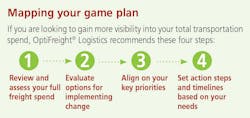Driving towards better outcomes
Healthcare delivery has evolved greatly over time. Modified reimbursement models and regulations require providers to deliver a new era of patient-centered care by implementing procedural and operational changes. Merger and acquisition activity among integrated delivery networks (IDNS) is also at an all-time high, causing healthcare systems to find new ways to simultaneously improve patient care and gain efficiencies across multiple sites of care. This has forced supply chain managers to find more strategic ways to save. One often underutilized savings method is managing total transportation spend.
Traditionally, hospital supply chains have used freight management providers to address their inbound small parcel shipments from suppliers. But today, managing freight costs requires much more than merely supplier shipments. “As providers acquire new facilities, such as surgery centers, hospitals, laboratories and pharmacies for instance, this much wider footprint creates more complexity and more duplication of efforts,” says Melissa Laber, general manager of OptiFreight® Logistics. “The more employees you have buying products, making shipping decisions, calling couriers, the more potential you have for transportation costs to be unmanaged and unnegotiated.”
Such scenarios make it increasingly harder for supply chain leaders to manage transportation spend efficiently and cost-effectively. In fact, research from OptiFreight® Logistics shows as much as 50 to 70 percent* of healthcare transportation spend is unmanaged because most systems lack the visibility needed to stay on top of so many transactions. With the help of OptiFreight® Logistics, forward-thinking supply chain managers interested in capturing more savings have charted a course of evolution in the healthcare freight management industry.
*Based on internal OptiFreight® Logistics customer data.
Riding out the evolution of freight management
While freight management starts with inbound small parcel shipments from suppliers, there is much more to address to achieve total transportation management. The evolution typically goes from inbound small parcel to heavy large freight shipments. Next comes managing outbound employee shipments, large and small. This requires more effort to socialize, train, and reinforce optimal shipping behaviors. Finally, same day courier and intra-network shipments are incorporated. Working with a comprehensive freight management provider, like OptiFreight® Logistics, provides IDNs the knowledge, resources, and insights required to tackle this complicated task.
“Just as healthcare is evolving at a fast pace, so is our business,” says Laber. “We started with inbound small parcel shipping expenses charged by suppliers, and then expanded to include managing large freight (over 150 lbs.),” says Laber. But what about the shipments that hospitals send, like home health equipment or patient prescriptions? Hospitals now also have access to reduced rates and visibility/reporting on outbound shipping through the same program. “The more visibility we have to packages coming in, within and out of your IDN, the more savings we can provide,” adds Laber.
Similarly, OptiFreight® Logistics also helps provide visibility and control of same-day courier shipments typically not managed under most current freight management models. Often, departments may source their own couriers and make costly decisions due to misunderstanding freight practices and affiliated costs. This is where having a dedicated freight management provider can make a huge impact. “In one of our customer locations, we found that the timing of the pick-ups and drop-offs for the linen service was creating piles of unwanted, soiled linens in the hallways, negatively impacting the patient experience,” explains Laber. After a thorough audit, OptiFreight® Logistics was able to amend the contract, eliminate multiple unnecessary courier stops, and keep the dirty linens away from the patients. “Our team loves working on challenges like this; just by having better visibility we were able to provide significant savings and enhance the patient experience.”
How much control and visibility do you really have over your shipping activity when considering the multitude of in-house transportation, third-party contracts, same-day couriers and overnight service providers used? In addition, how many different applications store shipping data, if it’s captured at all? That’s a lot of activity to aggregate and manage acrosconsolidation
s multiple locations, departments, people, and systems, all using different methods and modes of transportation to run daily operations. As consolidation increases, materials managers must make difficult decisions. Just as they decide which suppliers to order from, they must also select the right freight management provider that will capture the most savings across the continuum of care.
Get back in the driver’s seat
The need to find more savings, increase efficiencies, and focus on patient care is predominate across all health systems. “No matter what your level of sophistication is with healthcare freight management, we can help you develop a plan to maximize your savings,” says Laber. Designing and maintaining a strong transportation management system takes time, talent, and expertise, and using the right provider makes a huge difference. “We know our customers do not have the time to manage a fully comprehensive program on their own, and they should not have to.”
OptiFreight® Logistics by Cardinal Health™ manages over 19 million shipments a year, resulting in $475 million in savings for customers*. Visit cardinalhealth.com/optifreight to learn more or email [email protected] to request a transportation assessment.

